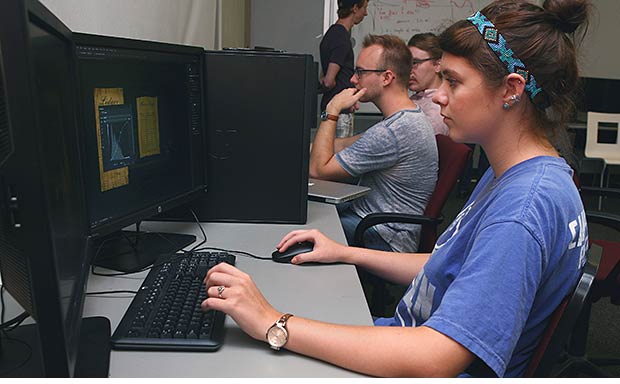Texas A&M gains stature among top video game design schools

Tim McLaughlin

Andre Thomas

Bill Jenks
Widely known as a fertile training ground for future Hollywood special effects professionals, the [Department of Visualization] (http://viz.arch.tamu.edu/) at Texas A&M University is rapidly gaining stature among the nation’s leading programs in video game design.
Since the Master of Science in Visualization program was founded at the College of Architecture in 1989, leading visual effects and animation companies like Industrial Light & Magic, Pixar and DreamWorks have snapped up its graduates. As it turns out, those graduates and their digital manipulation skills are also in increasingly high demand among companies looking to create the next “Minecraft,” “Halo,” or “Super Mario Brothers.”
The video game industry is setting [sales records] (http://www.gartner.com/newsroom/id/2614915) every year, with a market expected to reach $111 billion in 2015.
Responding to these trends, the Department of Visualization created gaming-oriented study options in their [master of science] (http://viz.arch.tamu.edu/graduate/ms-viz-curriculum/) and [master of fine arts] (http://viz.arch.tamu.edu/graduate/mfa-viz-curriculum/) degrees and also enhanced game design curricula at the undergraduate level.
A key part of the enhancement, said Tim McLaughlin, head of the department, was hiring André Thomas, an expert in digital content creation who led graphics development, planning and implementation for [EA Sports] (https://www.easports.com) ’ powerhouse video football games before joining the Texas A&M visualization faculty in 2014.
“His knowledge of games from an industry perspective, combined with his vision of how games can be developed and used to transform the approach to a wide variety of problems in visualization has made an enormous impact on our department,” said McLaughlin.
The result of these efforts was confirmed in a recent [survey] (http://www.prnewswire.com/news-releases/the-princeton-review-ranks-top-25-undergrad--grad-schools-to-study-game-design-for-2015-300054915.html) placing Texas A&M among the world’s top schools for studying game design. The survey, conducted by The Princeton Review, a leading test preparation and college admission services company, included 150 institutions that offer game design coursework in the U.S., Canada and abroad. Texas A&M’s graduate visualization programs placed 22 nd .
"For students aspiring to work in the burgeoning field of game design, these are truly the cream-of-the-crop institutions from which to launch a career," said Robert Franek, The Princeton Review's senior vice president and publisher. “All are renowned for their exceptional faculties and awesome, state-of-the-art facilities.”
The newest gaming education facility at Texas A&M is the Department of Visualization’s [Learning Interactive Visualization Experience Lab] (http://live.viz.tamu.edu/) , headed by Thomas. The lab, established in 2014, provides space for graduate and undergraduate students to create game prototypes while learning about game theory, the art and science of the visual image and game history.
In the lab, through research and rigorous scientific process, students collaborate with specialists from visualization, educational psychology, computer science and engineering to create innovative, interactive software.
Two educational games are currently [under development] (http://one.arch.tamu.edu/news/2014/10/9/viz-prof-lead-educational-games/) in the lab. In one, “The ARTé Project,” players explore a 15th century Italian palace to learn about art, artists and how Western culture flowered during the Renaissance. The other game is especially designed to help students succeed in a challenging Texas A&M calculus class.
LIVE Lab students also work with industry partners including EA, [Epic Games] (http://epicgames.com) and [Side Effects Software] (http://www.sidefx.com) , whose professionals mentor student game development teams and provide guest lecturers.
“The department also offers design courses, art courses and technical courses for graduate and undergraduate students that are not necessarily specific to gaming, but teach students color theory, artistic and other skills that are required for a successful career in gaming,” said Thomas.
Visualization faculty, said McLaughlin, also specialize in topics important to the future of game design, including research investigating augmented reality on mobile devices and the [development] (http://one.arch.tamu.edu/news/2015/3/10/interactive-toys/) of alternative computer interaction techniques.
Former students have gone on to work at numerous game design companies, including EA, Certain Affinity, BioWare, gumi America and Virtuix Omni.
Representatives from several of these companies also serve as Visualization Industry Partners, a board that advises the department of current and future industry trends.
The multifarious gaming-related educational offerings in the department exemplify its emphasis on training students to master the art and the science of their chosen field.
“Our curricula, at both the graduate and undergraduate levels, requires every student to be an aesthetically astute artist and a clever technologist,” said McLaughlin. “The combination works well in a variety of fields and has a particular impact on game design and development.”
Skill sets students acquire for successful careers in gaming also overlap those needed for careers in digital special effects and 3-D modeling, said Bill Jenks, assistant department head.
Many former visualization students can be found among the creative talent at [Pixar] (http://www.pixar.com/) , [Blue Sky] (http://blueskystudios.com/) , [Walt Disney Animation Studios] (http://www.disneyanimation.com/) , [Industrial Light and Magic] (http://www.ilm.com/) , [Dreamworks Animation] (http://www.dreamworksanimation.com/) , [Electronic Arts] (http://www.ea.com/) , [Rhythm & Hues Studios] (http://www.rhythm.com/home/) , [Reel FX] (http://www.reelfx.com/) and [Sony Pictures Imageworks] (http://www.imageworks.com/) .
- - -
Press contact: Richard Nira rnira@tamu.edu or 979.845.6863
Tags
- academics
- archone gallery
- building a better texas
- coa gallery
- partnerships
- rss
- visualization
- viz gallery
Related Posts

Initiative fusing arts, technology education gains momentum

Esteemed former students create leadership minor

Teacher 'making’ workshop fosters STEM education

Micro-manufacturing initiative earns NSF Convergence Award
Follow Us
Facebook Twitter Vimeo Youtube Flickr RSS
Recent Posts

Planning prof heads study of disaster housing aid

A message from the dean

Former student remembered as expert planner

Leading educator named new head of Architecture Dept.






_thumbnail_small.png)
